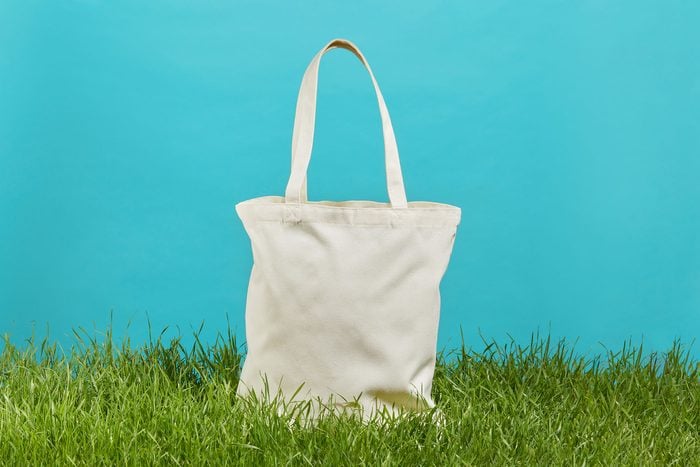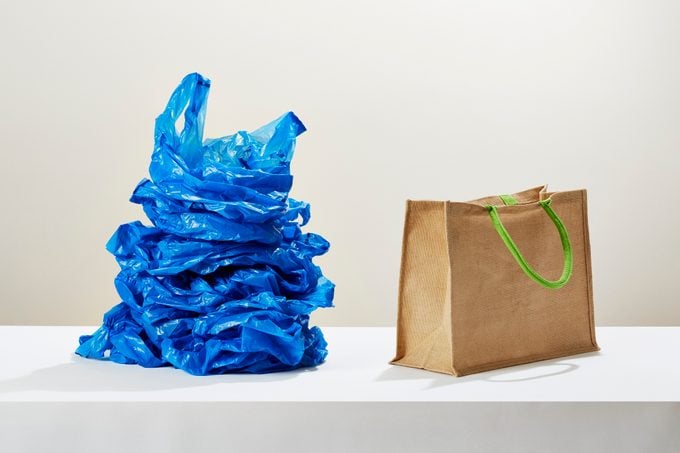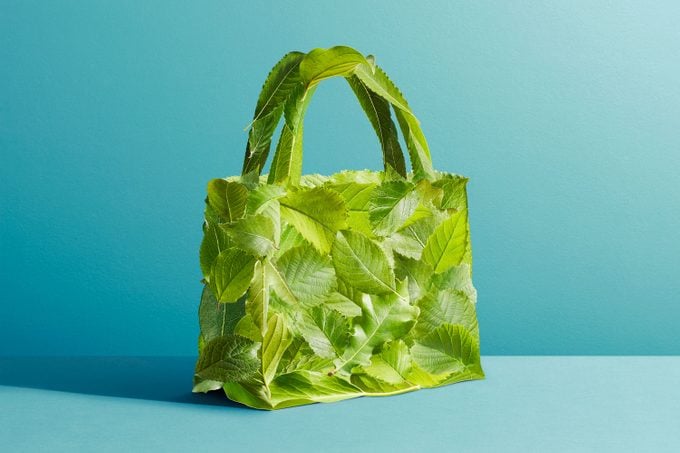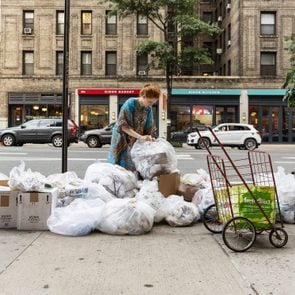Are Reusable Bags Good for the Environment?
Updated: Apr. 10, 2024

Canvas bags and tote bags are alternatives to single-use plastic. But really, are reusable bags good for the environment?
Single-use plastic bags are a major contributor to the global pollution crisis and a menace on our path to sustainable living. In fact, according to The World Counts, we use 5 trillion plastic bags per year. That breaks down to 160,000 plastic bags per second and over 700 a year per person. Plus, it’s been estimated that 300 million plastic bags end up in the Atlantic Ocean every year. It’s no wonder that 127 countries around the world are regulating plastic bags and encouraging reusable bags for the planet. But, are reusable bags good for the environment?
With the success of life without plastic campaigns, an interest in sustainable brands and Americans’ openness to recycling, the popularity of eco-friendly products continues to grow. Many have swapped their usual plastic grocery bags for more “eco-friendly options,” like canvas bags and tote bags. But while we can agree that the once-ubiquitous plastic bag needs an alternative, is there evidence that reusable bags are the best solution? We let you know below!
Get Reader’s Digest’s Read Up newsletter for more environmental tips, fun facts, humor, cleaning, travel and tech all week long.
Are reusable bags good for the environment?

It depends! Reusable bags can be used over and over and are the obvious solution simply because they create less waste in the long run.
But, different types of bags will have a different impact sustainably. The term for determining a bag’s environmental impact is “life cycle assessment” (LCA), which looks at the raw materials, manufacturing, use and reuse, and the final disposal of a product. According to a report by UNEP, “depending on their composition, reusable bags might have to be deconstructed in a costly recycling process to separate the different materials. Consequently, in many cases, reusable bags are not recycled.” That means that despite the best intentions, millions of reusable bags, designed to replace the need for conventional plastic shopping bags, will also end up in landfills.
How often you use a bag matters
Reusable bags are only successful in creating less waste if people use them often enough to justify the manufacturing process and the resources needed to make them. The number of times a bag is used directly influences its environmental impact—the same goes for reusable water bottles or reusable coffee cups. As a rule of thumb, the more durable a bag is, the longer it will last and be used. In one life cycle assessment of grocery store bags by the U.K.’s Environment Agency, conventional cotton totes should be reused 131 times, plastic bags 11 times and a paper bag three times to reduce their global warming potential.
Materials matter
The manufacturing process and raw materials will determine your reusable bag’s environmental impact. One alternative is paper bags, which are biodegradable but generally aren’t durable enough to be used as often as fabric tote bags. There are also concerns about deforestation—NBC reports that the U.S. alone fells approximately 14 million trees per year to make paper shopping bags.
Cotton canvas totes are another option. They’re lightweight, can be biodegradable and are more durable than standard plastic and paper bags. However, it takes a lot of land and water resources to produce conventional cotton, and manufacturing these totes requires a lot of energy.
Reusable bags might even be made from recycled plastic, polyester or nylon (plastic-based fabrics). These bags can be as durable as cotton totes, but still raise environmental concerns, since they rely on crude oils as raw material and can require a lot of energy and water resources to produce. Also, washing polyester or nylon bags can create microplastics, tiny pieces of plastic that flow into the ocean and other water sources.
Are reusable bags recyclable?

According to the Environmental Protection Agency, recyclable materials are those that can be collected, sorted, processed and eventually manufactured into another item. When learning how to recycle and dispose of your reusable bags properly, you’ll find that most options don’t involve a landfill. There are simply different approaches based on the material (and those recycling symbols).
Recycling paper bags
In theory, paper bags are made from trees and are biodegradable, recyclable and compostable. If your city recycles paper bags, you can place them in your recycling bin as long as they are clean (not soiled with oils or grease). However, each city or municipality has different recycling capabilities, so review their guidelines on paper bags.
Recycling cotton totes
While plastic and metal can be melted down and reused when recycled, cotton must be mechanically separated and processed. So how the material has been processed will impact how it’s recycled. Unfortunately, if synthetic material is mixed with cotton, it cannot be processed for recycling. Because many facilities don’t have machinery built for cotton totes, you shouldn’t just drop them in the recycling bin.
Here’s the good news though: If the bag is made from organic cotton and plant-based inks and dyes, you’ll be able to compost it. This is a natural process where organic materials turn back into raw organic matter over the course of several months. Sometimes, it involves the help of wiggly creatures like worms. It’s also one of the best disposal methods, since it’s zero waste. Typically, organic cotton items are certified in the U.S. and will have a logo.
To determine where you can send your compostable waste, use resources like Litterless to find composting facilities near you. You can also donate your cotton totes to local shelters or Goodwill storefronts. If your cotton totes are beyond reuse, you can use a service like Retrievr, which will properly recycle cotton materials for you.
Recycling reusable plastic bags
Some plastic bags are made to be reused. Many are thicker with wider handles to hold more weight. Others are made from polyester and might feel like a satin or cotton fabric. Some reusable plastic bags are even made from recycled ocean plastics. Since these reusable bags for the environment are made from plastic, make sure to research whether they can be placed into your recycling bin. Not every city in the U.S. has recycling machinery that can properly handle upcycled plastic. If your city does not accept any type of plastic bag in the curbside recycling program, visit your local grocery store to see if they’ll take back and recycle reusable plastic bags. Or use tools like Plastic Film Recycling to access a directory of locations that accept reusable plastic bags.
How to choose the best reusable bags (and make them last)

Generally speaking, the most sustainable bag is one that you will carry with you and use often. On a life cycle basis, stronger bags—no matter what material they are made from—will allow you to reuse them more often and have a smaller environmental impact.
If you’re looking for a bag that can carry all your sustainable must-haves as well as essentials like your laptop, phone, keys and wallet, a classic organic cotton tote might be best for you. This carry-all-day bag can replace your other bags, act as a convenient commuter bag or be stored in the car for last-minute grocery trips. Best of all, you can simply throw these in the wash to clean them. Since cotton is prone to shrinking in the dryer, remember to hang your bags—not only will this save your tote, it’ll also save energy.
If you prefer a reusable bag strictly for groceries, something insulated might be best. Or perhaps you’re looking for something compact and available at a moment’s notice. If so, a recycled nylon Baggu bag could be a good option (they’re built to hold 50 pounds worth of items but fold up to the size of your fist). To care for plastic, polyester or nylon bags, skip the washing machine, which can release microplastics into the atmosphere, and wipe them clean with a damp cloth and soap.
What to do with tote bags once you’re done with them
Give those reusable bags for the environment a second life once you’re done with them. If a few seams are coming undone, why not try resewing them? If that’s not an option, find other ways to upcycle your bag. An organic cotton tote can be recycled or used as a planter for plants—you can even grow tomatoes in old tote bags. Another idea: Use the fabric as wrapping paper. Of course, if you can’t upcycle or reuse your bag, the next best way to dispose of it is to find out whether it can be recycled.
Additional reporting by Elizabeth Marglin.
Why trust us
At Reader’s Digest, we’re committed to producing high-quality content by writers with expertise and experience in their field in consultation with relevant, qualified experts. We rely on reputable primary sources, including government and professional organizations and academic institutions as well as our writers’ personal experience where appropriate. We verify all facts and data, back them with credible sourcing, and revisit them over time to ensure they remain accurate and up to date. Read more about our team, our contributors and our editorial policies.
Sources:
- The World Counts: “How many plastic bags are used each year?”
- National Geographic: “Fast facts about plastic pollution”
- National Resources Defense Council: “NRDC Lauds Passage of New York City Council Legislation Requiring Groceries, Retailers to Provide Plastic Bag Recycling for Consumers”
- United Nations Environment Programme: “Plastic Pollution”
- United Nations Environment Programme: “Single-Use Plastics: A Roadmap for Sustainability”
- Life Cycle Initiative: “Single Use Plastic Bags and Their Alternatives”
- Organic Trade Association: “Organic Cotton: It’s better for the environment, and here’s why”
- Environment Agency: “Lifecycle assessment of supermarket carrier bags”



